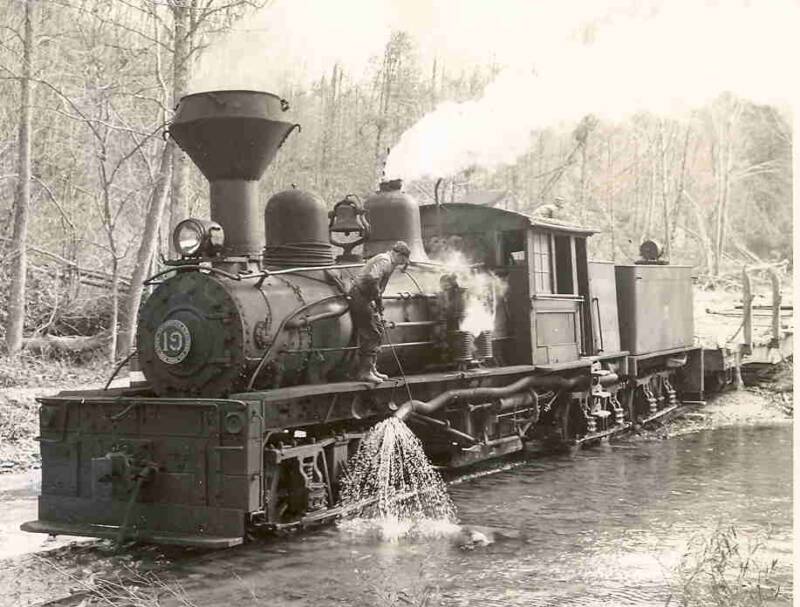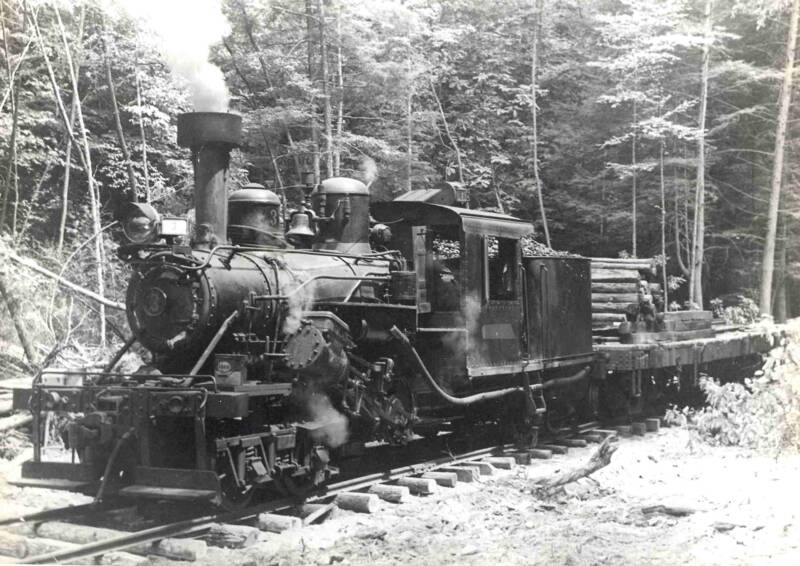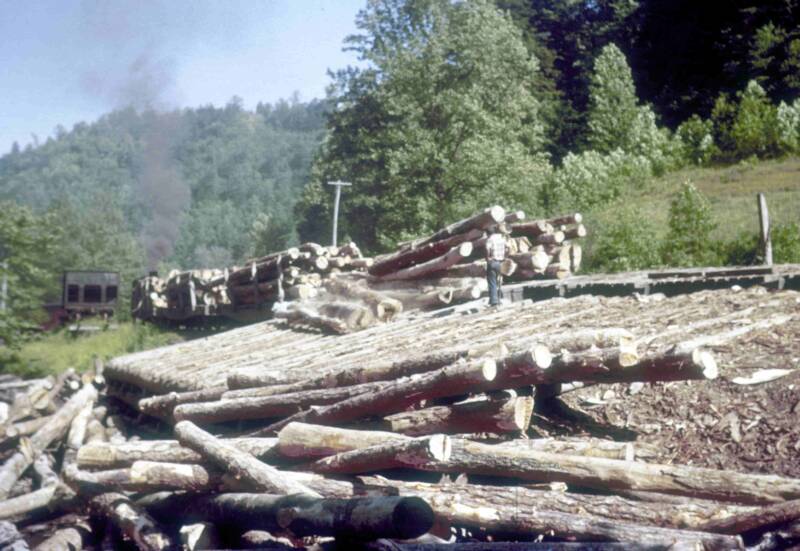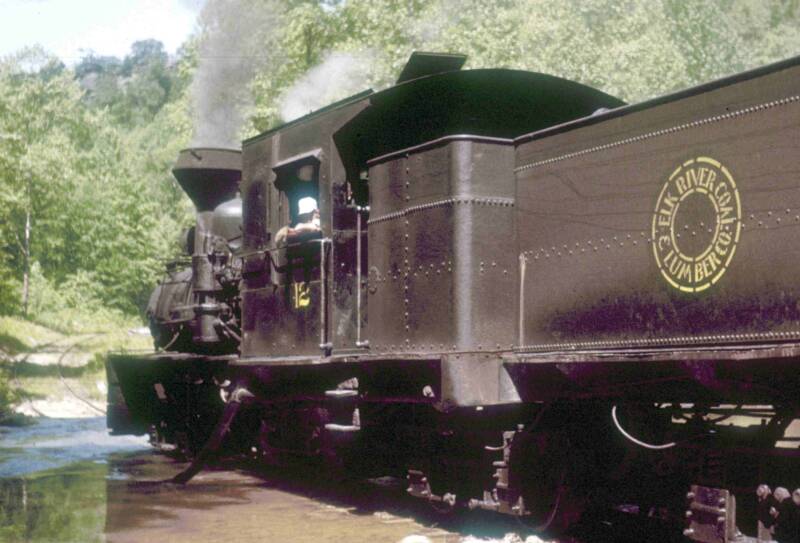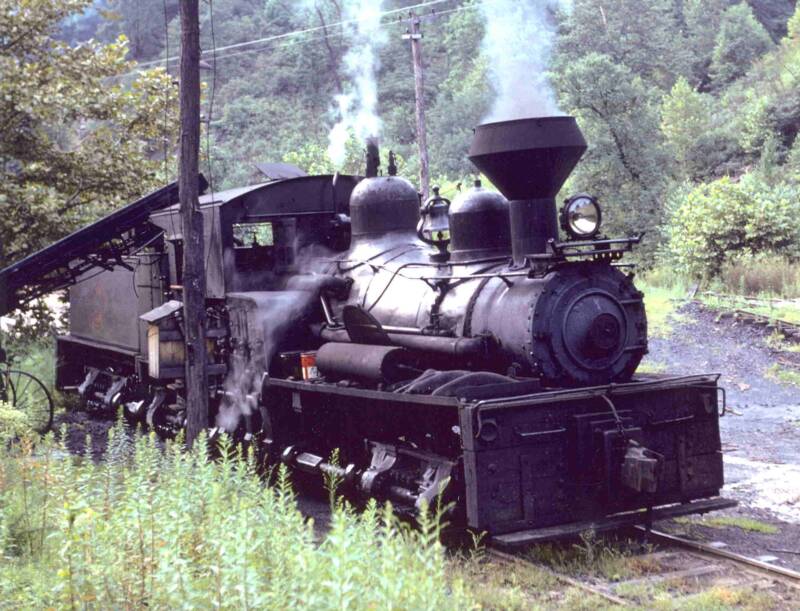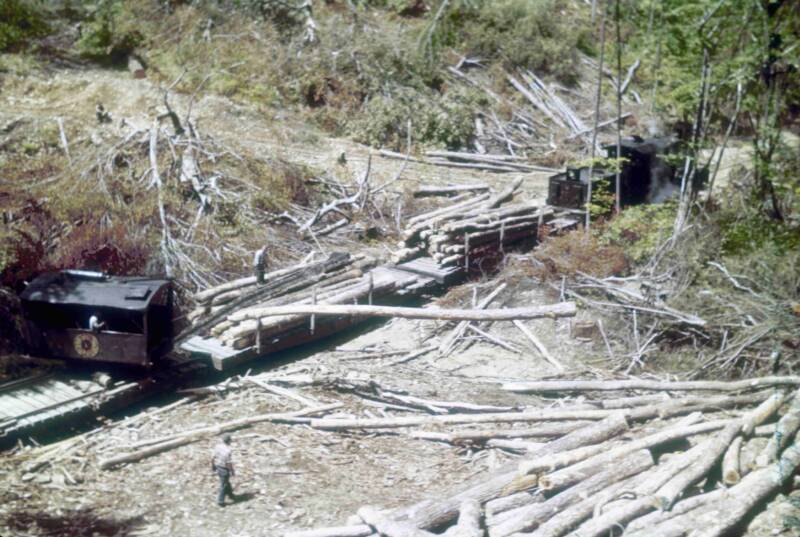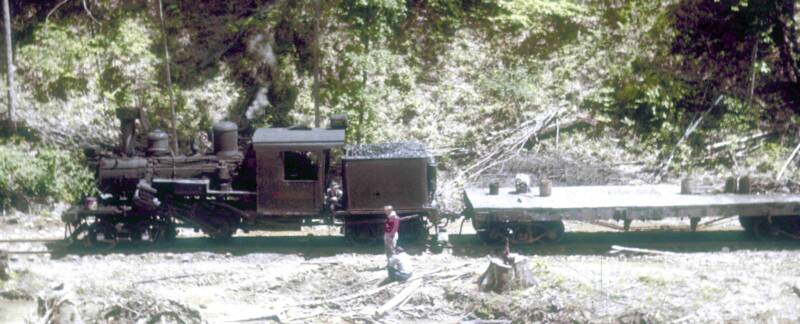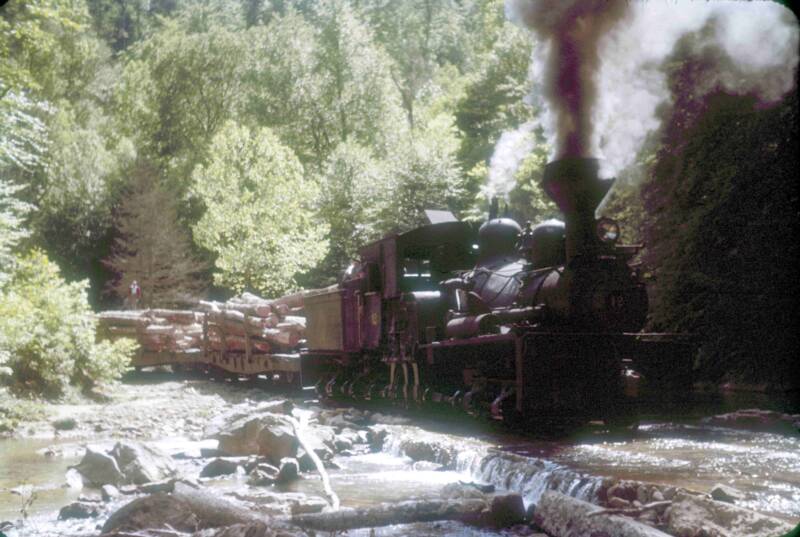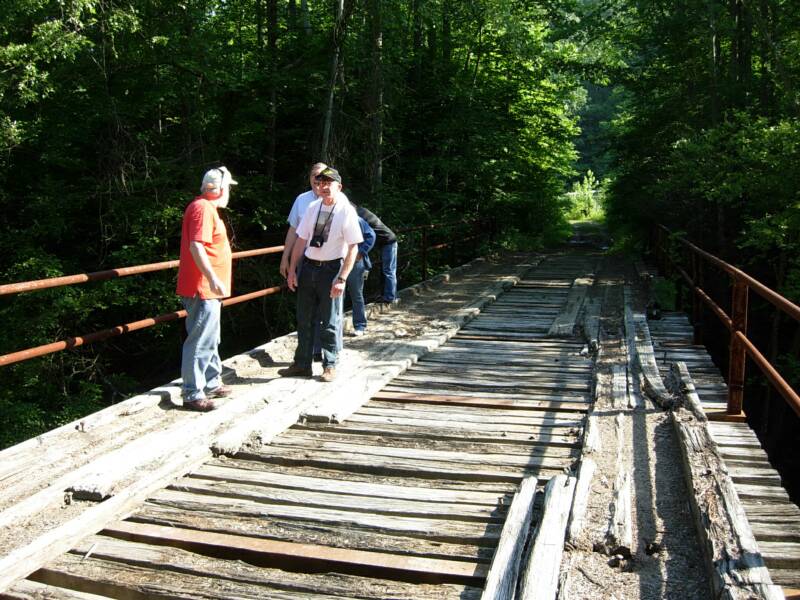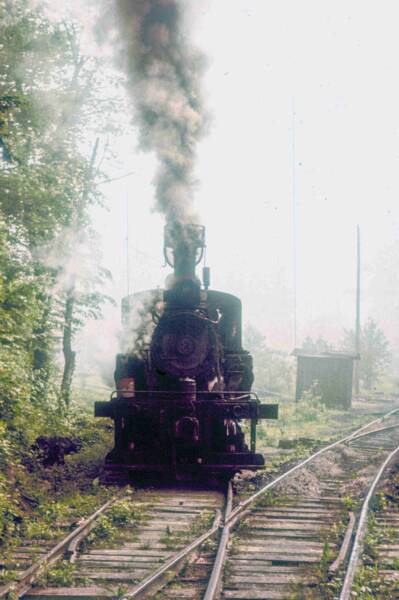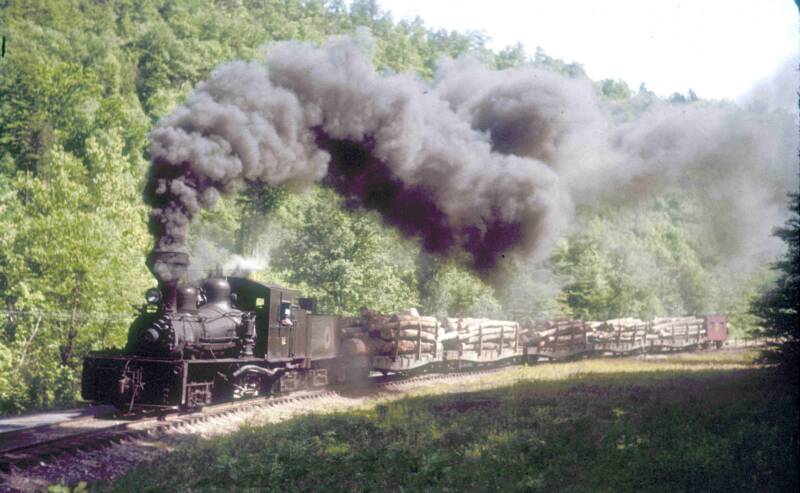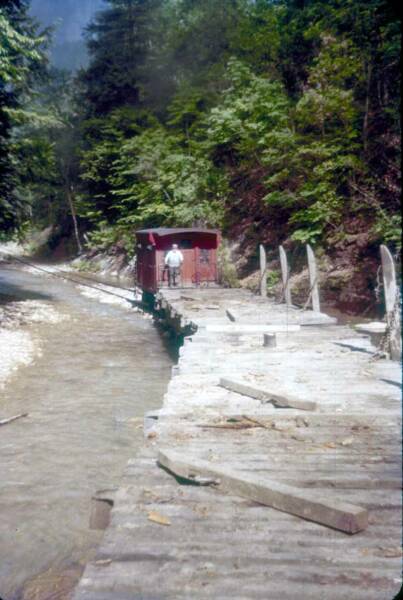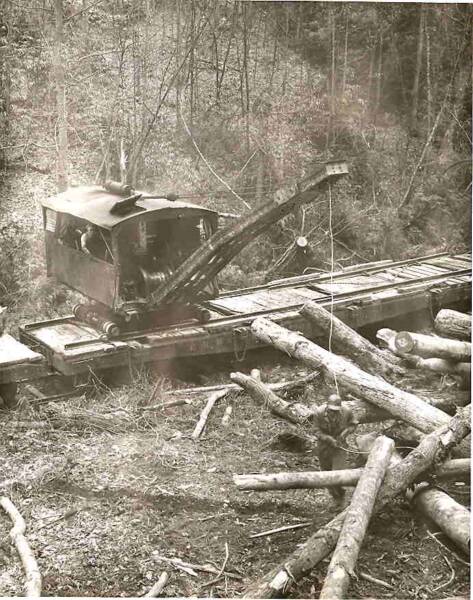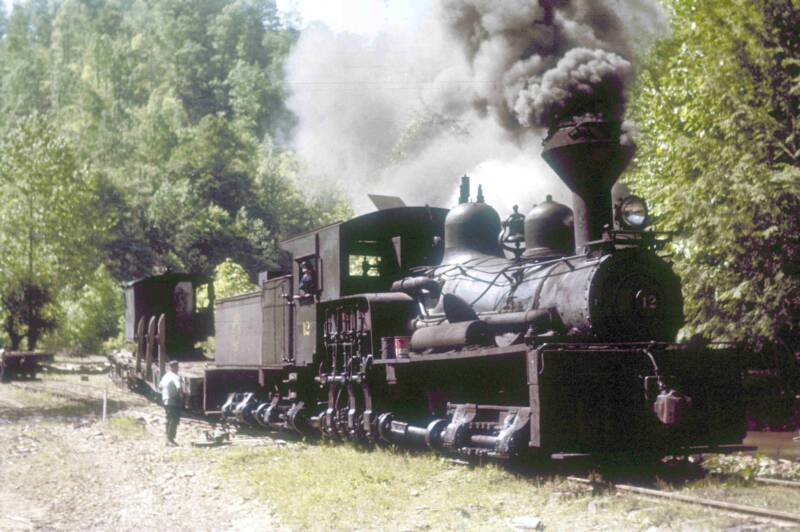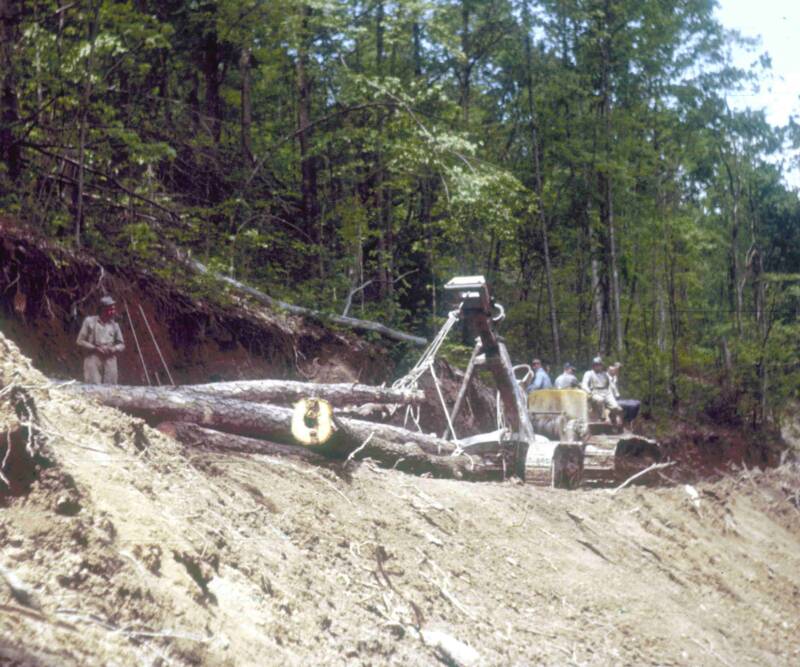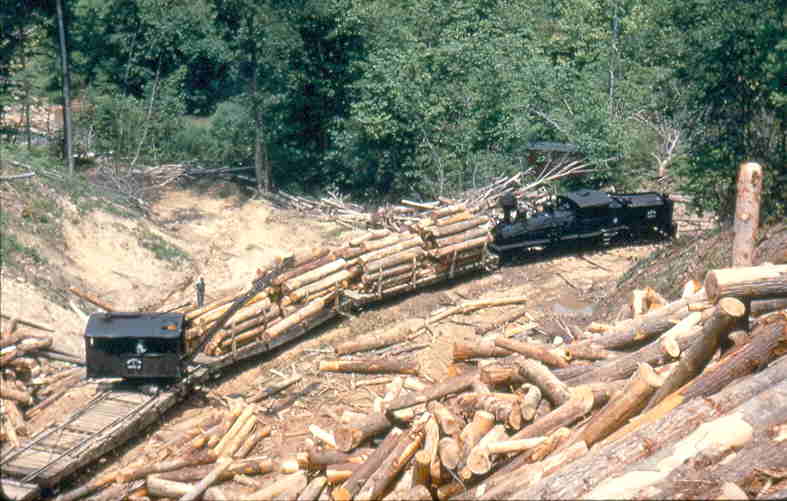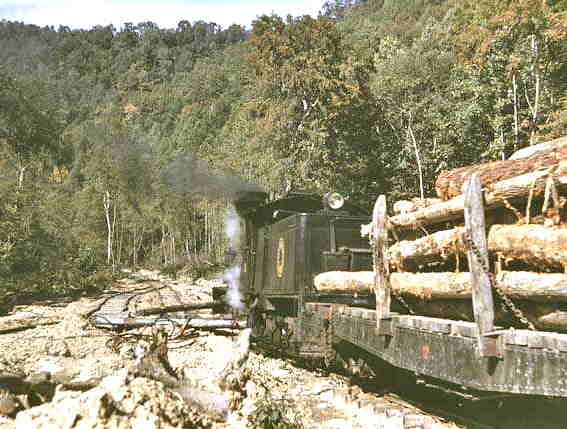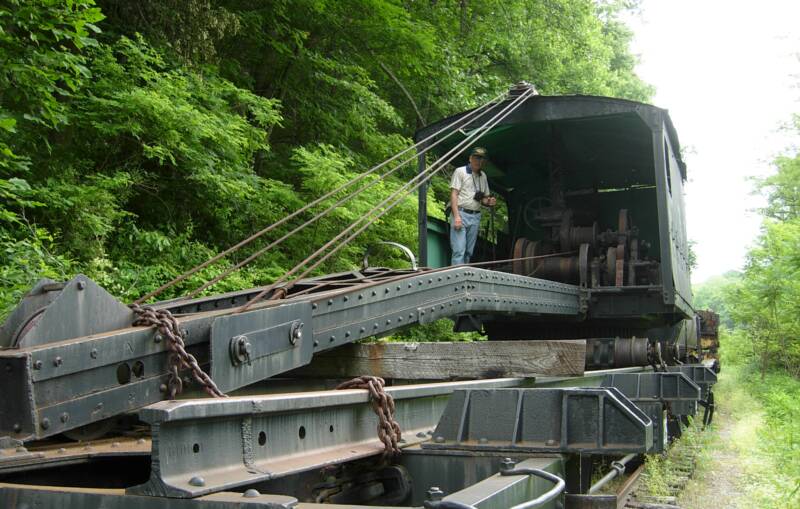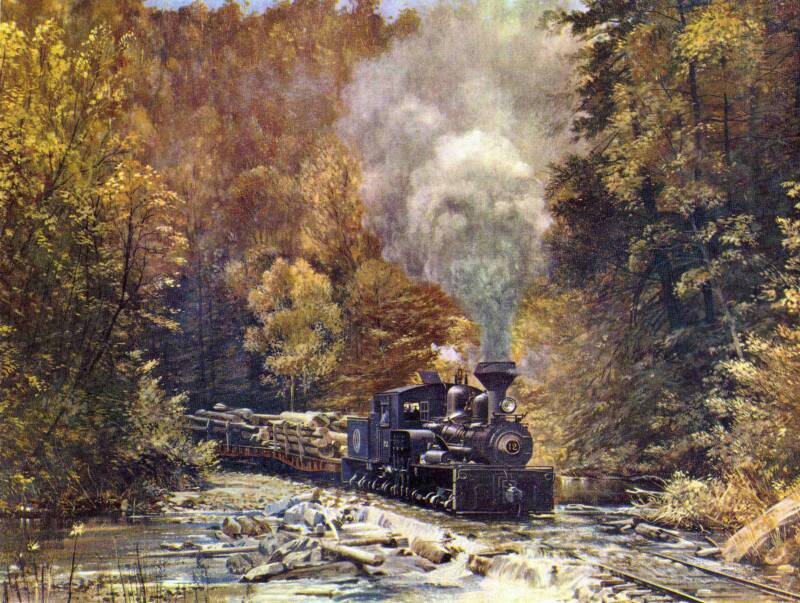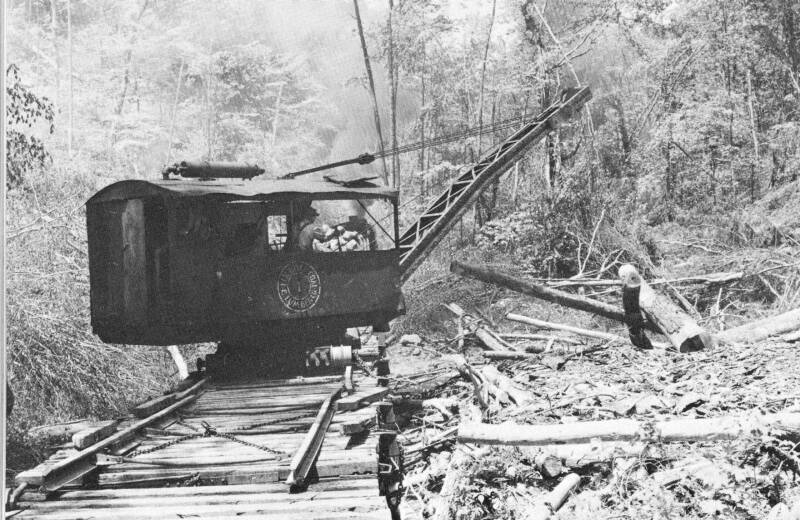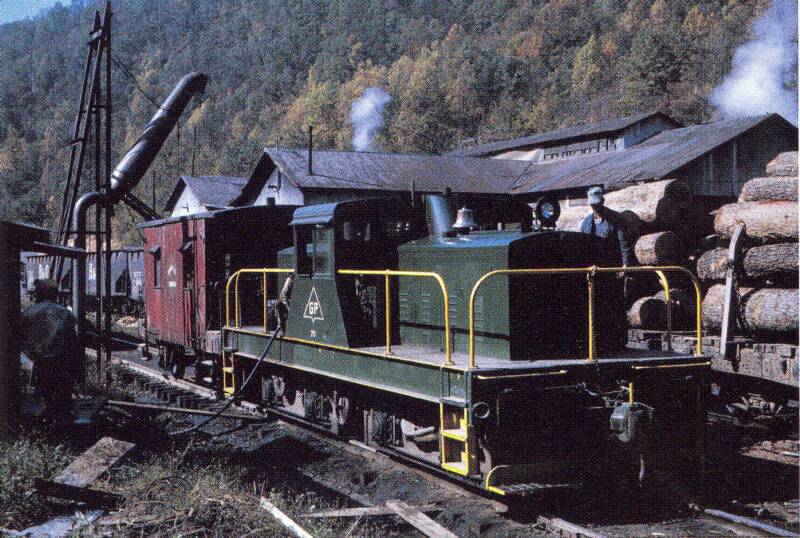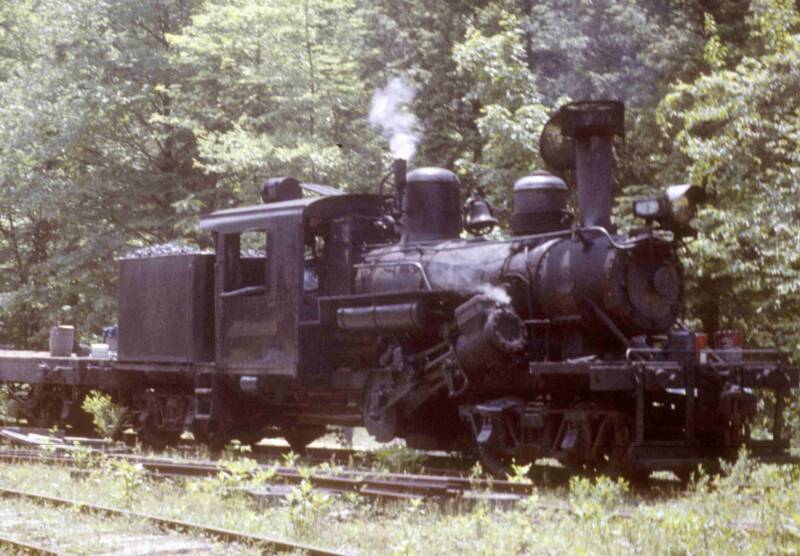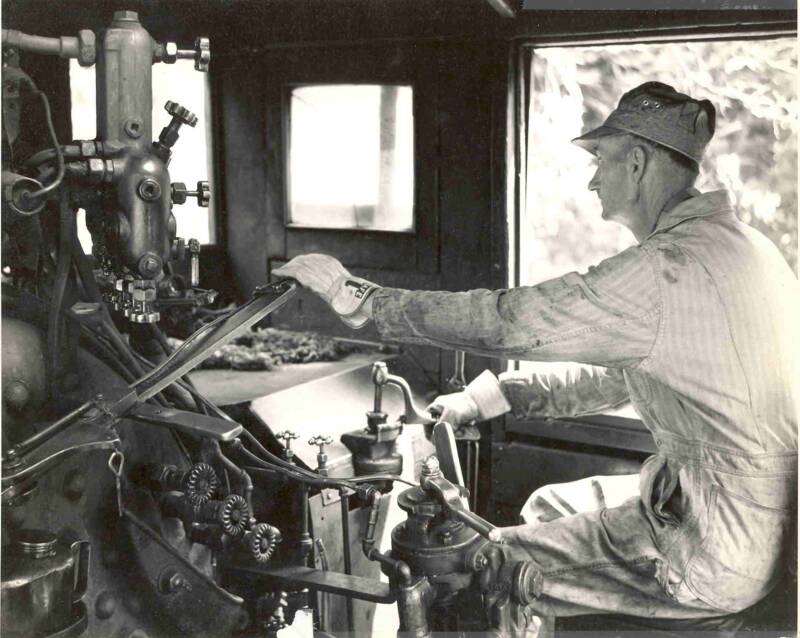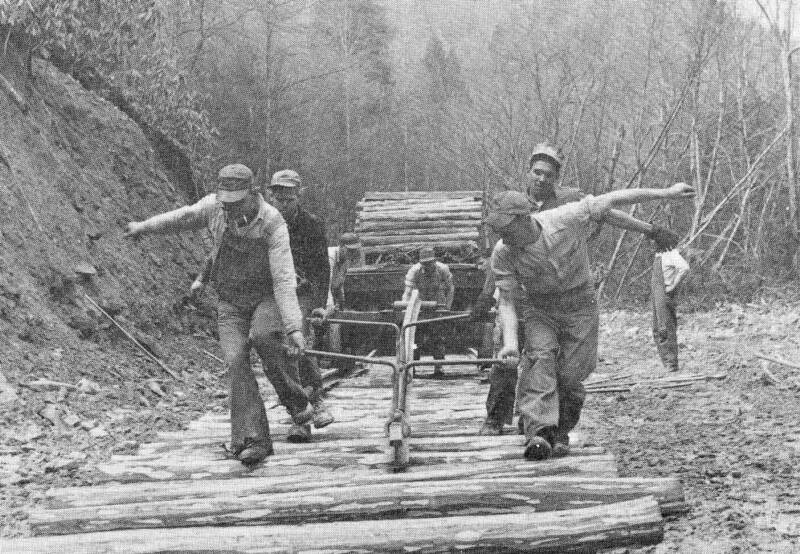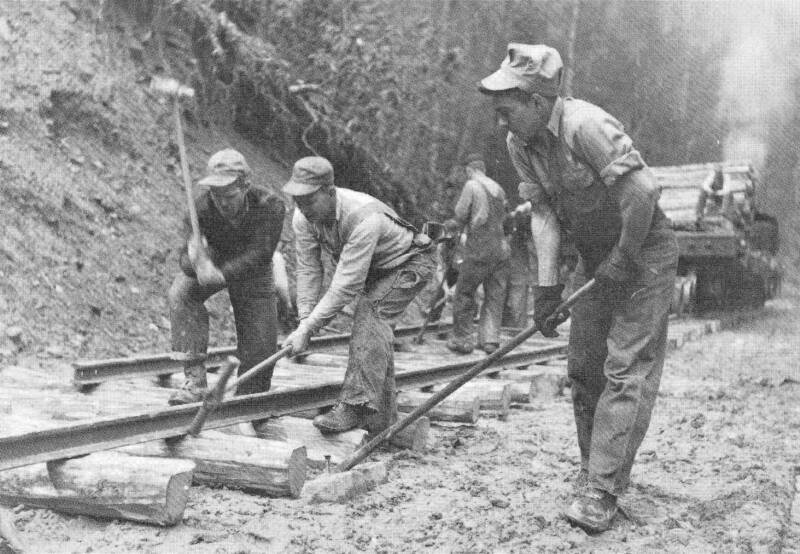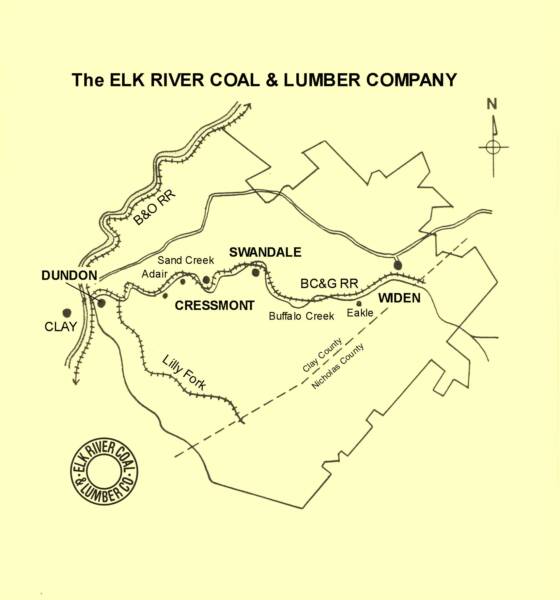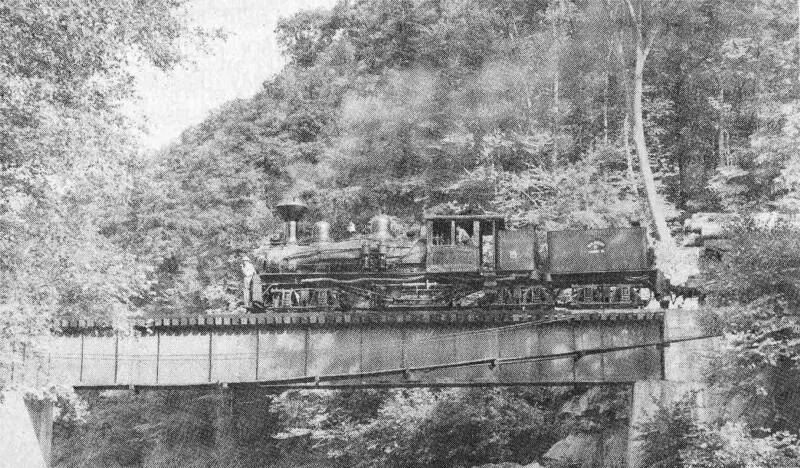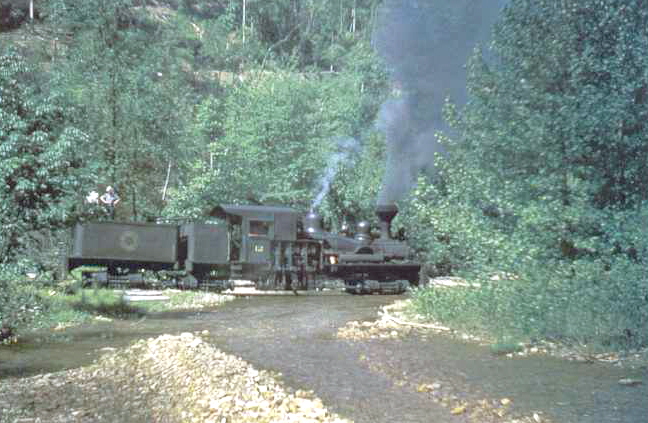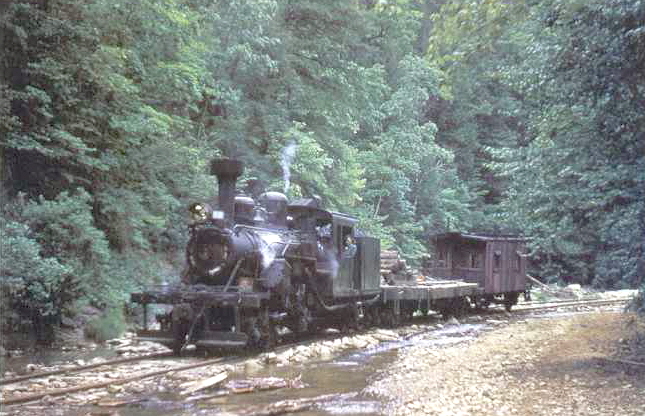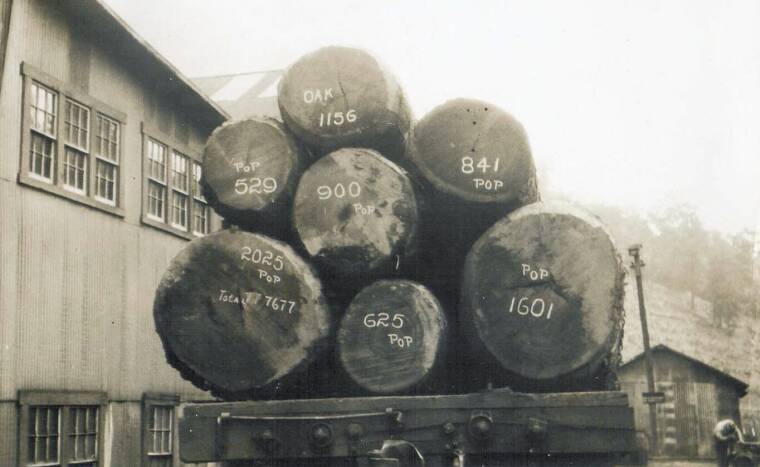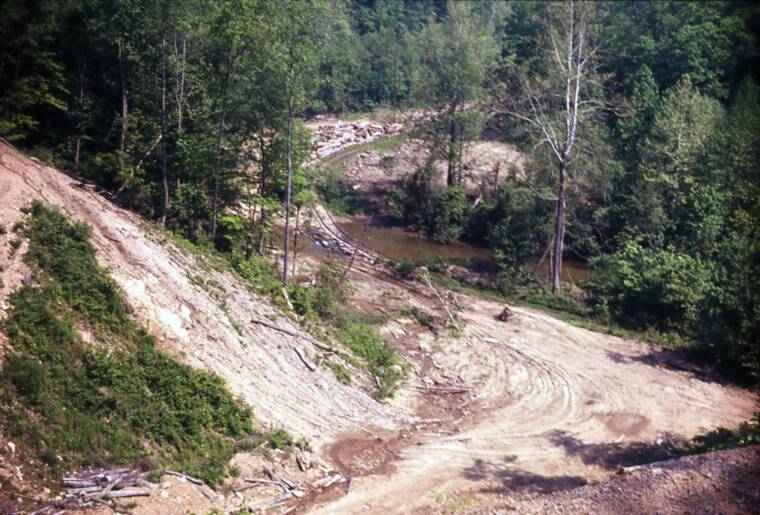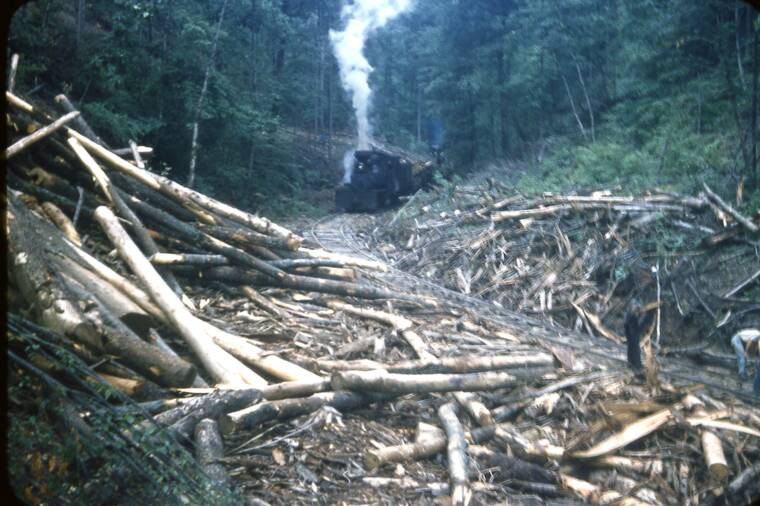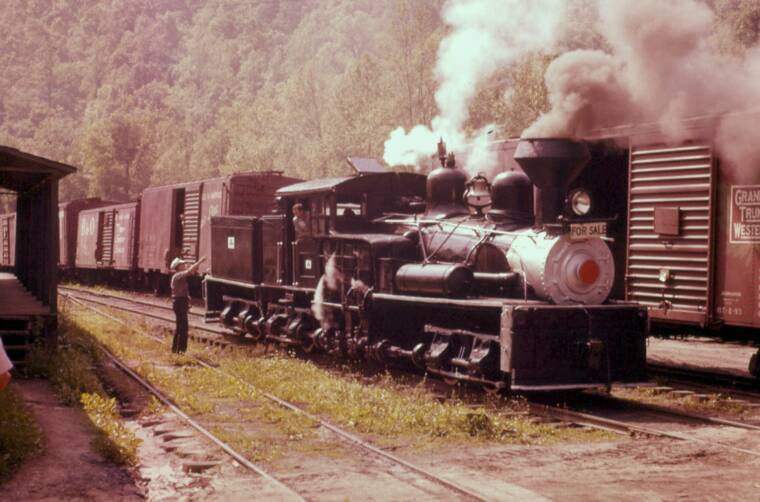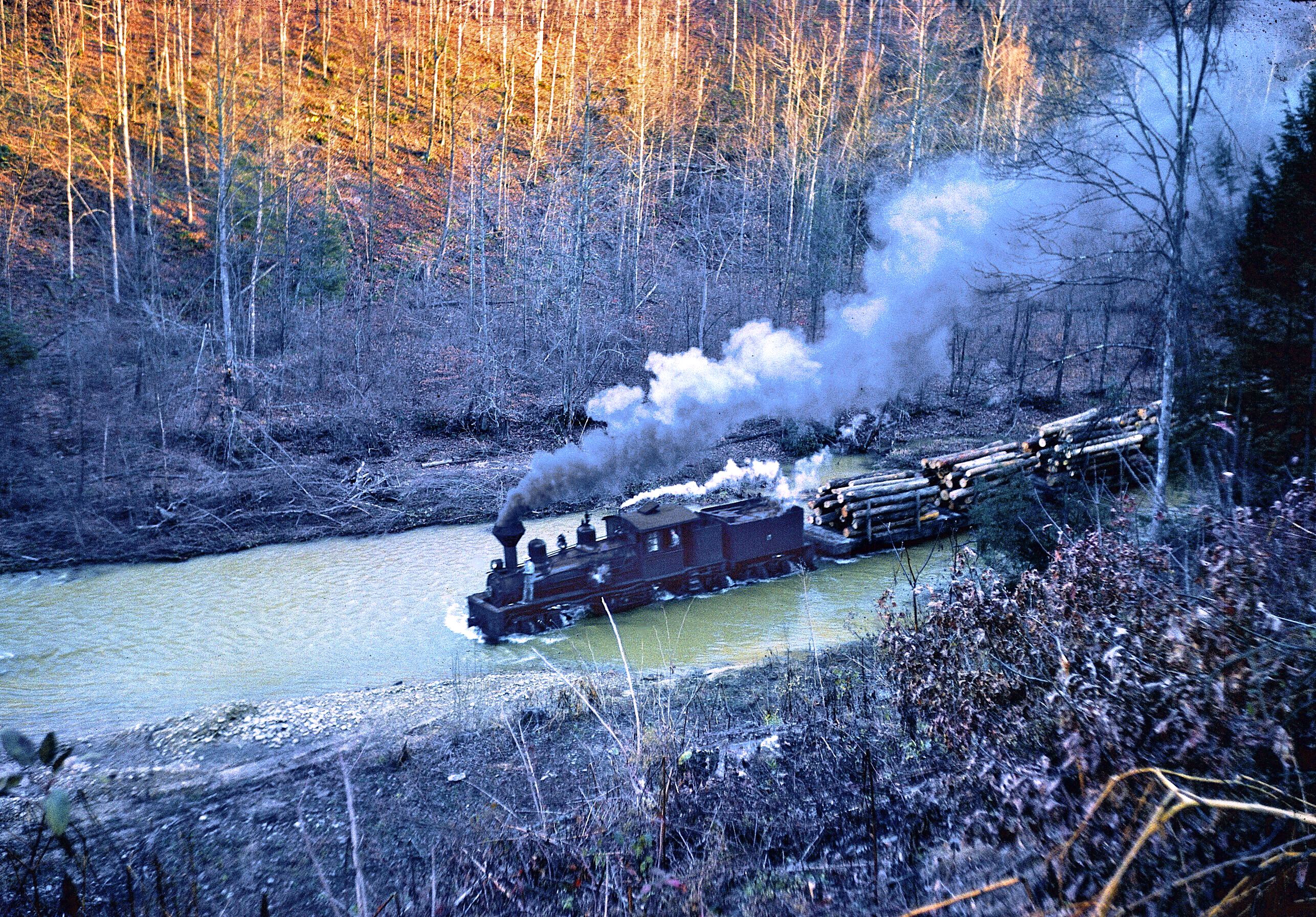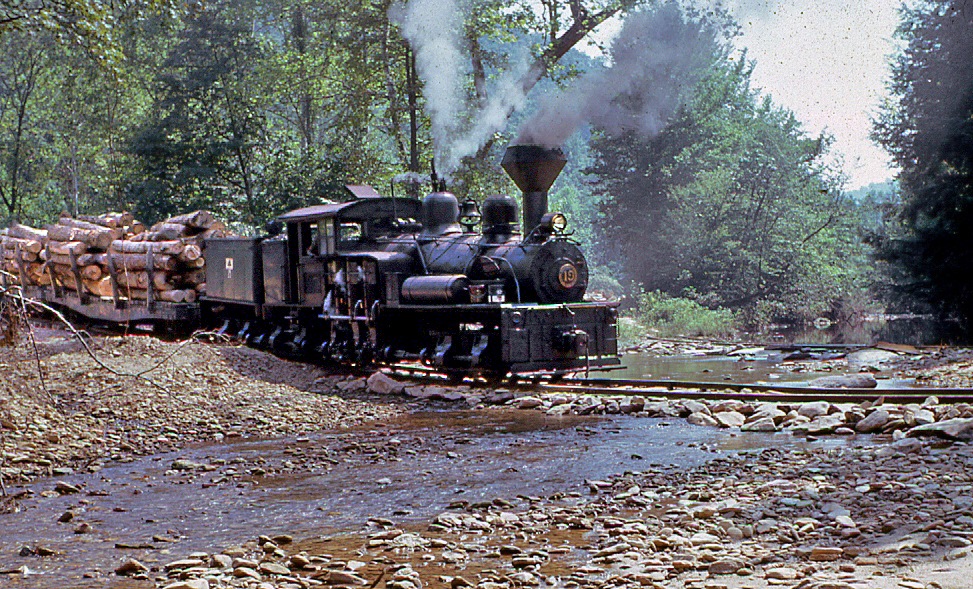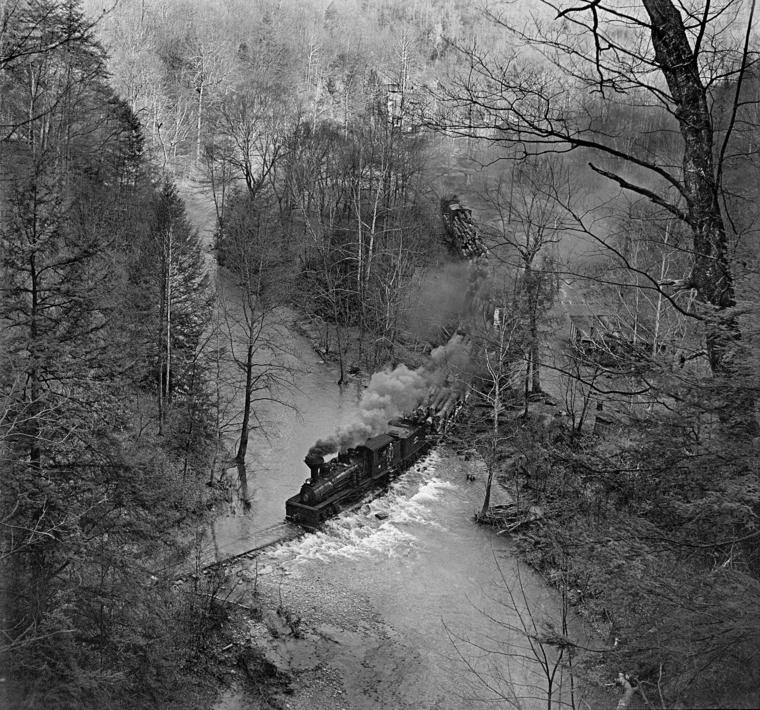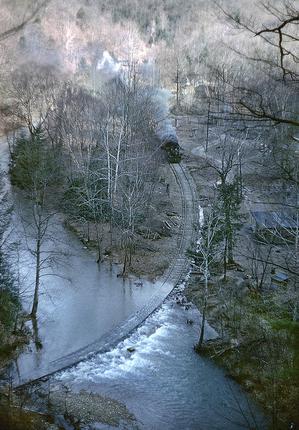ERC&L Logging Operations
If it wasn't for Cody Burdette, this section of the website couldn't have been written! Cody has generously provided much of the insight into the operataions of the ERC&L logging activities presented here. Theodore Burdette, Cody's dad, moved his family to Swandale in 1950. Ted became an engineer for the railroad and operated Shays #12 and #19 for many years, ending his career running Plymouth diesel #20. The photo to the right shows Ted at the throttle of #19 in June of 1962. Cody was employed on the ERC&L from 1956 through 1959 doing a number of jobs, including tending the fires in the geared engines overnight. Around the family dinner table, Cody heard, and now recalls, alot of stories about the operation of the logging trains. While not a "licensed" engineer, his dad let Cody operate the engines on many occassions. From ERC&L fans all over the land, thanks for your help, Cody! And a special thanks, too, to David Marquis who took advantage of a trip on the log train to take some wonderful and rare color photos!
Swandale
The ERC&L's operation was typical of most any backwoods logging line. Equipment was typically second hand. Track was simple and the routing changed regularly as the areas being logged changed. From an operating standpoint, however, the ERC&L logging trains had an extra element to deal with. The ERC&L trains used the BC&G track from Swandale west to the wye at Avoca where the Lilly's Fork logging line headed off into the woods (see map below). SInce Cody has been able to so accurately recount the activities during the mid-1950's, that's the period I'll describe here. It wouldn't have been much different during any period, I don't suspect.
As Cody tells it, after having tended the fires in the geared engines overnight, around 4:00 am he started to build the pressure in the boilers in preparation for the day's run. At around 5:00 am, "with fog still hanging over the log pond", the engineers, including Cody's dad Ted and Creed Truman, would arrive and take over the preparation of the engines. Cody would go get some rest!
Normally, departure was scheduled for around 6:00 am. This would allow the log train to get in the clear at Avoca before Railbus "A" or the coal train departed Dundon.
There was a siding in Swandale specifically for coaling the engines. This rare photo shows #12 sitting under the conveyor loader. Cody recounts that the conveyor did not appear until very late and for many years coal was shoveled by hand.
Art Huneke photo - August 1956, Cody Burdette collection
ENGINE OVERNIGHT STORAGE
Cody reports that the engines were stored at the end of the spur that went behind the log pond that led to the power plant. On some nights that would have been #3, #12 and #19. That was done because the same guy responsible for the engine fires (often Cody!) was also responsible for keeping the fires properly banked in the sawmill. This way, he didn't have to walk far too tend all his charges.
The fires were put out in the engines on the weekends during the summer when no trains were run.
SAWMILL INSPECTOR, TOO
Besides being responsible for tending the fires in the locomotives, Cody was responsible for continuously making rounds in the sawmill throughout his 12 hour shifts.
LILLY, LILY or LILLY'S FORK?
In the course of the research for this website I have seen the name of the logging branch spelled three different ways. When I approached Cody about this subject, he said the folks on the railroad always referred to it as "Lilly's Fork". That's good enough for me!
LEAKY TENDER ON #12
Cody fondly recalls that before she was retired, the tender on Shay #12 leaked so badly that he had to add water overnight while just keeping the fire banked!
Brooks Stover - June 2007
I think this wonderfully lit photo by Dave Marquis perfectly captures the character of the ERC&L. Here Climax #3 idles quietly in the morning fog. David Marquis' notes show the photo at Avoca, however Cody Burdette believes it was taken at Starchers. The track to the left was used for storage of supplies and fuel. The main line up the Lilly is going off to the far right. The engine is sitting on the siding it occupied at night.
David Marquis - circa 1958
Starcher's Logging Camp
Besides the log train, the ERC&L usually operated a second train each day. This train, sometimes referred to as "the steel train" was pulled by Climax #3. It pulled a flat car or two and hauled the rail, ties and tools to lay track.
The two photos (above) of the steel train tell the story of the simplicity of the operation. The lightweight construction of the trackwork used in the woods is evident in the right-hand photo under the engine. The ties were rough-hewn logs, the rail was light, and the whole affair laid on crude roadbed.
The procedure for laying rail was equally simple...manual labor..as shown in the photo below from Warden's BC&G book, page 36. Not that the "ties" in the right hand photo don't appear to be anything more that logs. Flat spots have not even been hewn in the top surface!
Lilly's Fork
It's generally reported that Lilly's Fork stretched about 9 miles into the woods. Of course, its length varied as logging locations changed. At 9 miles, however, it was half the length of the BC&G "mainline"! More notable than the length, however, was the crude nature of the track.
The two photos above and the one the right and the one below shows just how crude the track work on Lilly's Fork was. Just visible in the Baum photo is a short passing siding. These were common, but there was no wye in the woods so log trains backed to Avoca at the end of the day, according to Cody.
In the Marquis photo below, Shay #12 is picking up the log loader at the start of the day from one of the sidings where it likely had spent the night.
David Marquis - circa 1958
The ERC&L American log loader was converted from its original steam power to diesel sometime around 1945, according to Cody. It was a fascinating machine in that it made the log train a "self-loader". As clearly visible in the wonderful photo above as well as the two to the left, the loader rode on two crude sets of "sectional track". The two sets were of different gauges, one to match each gauge of the loaders unique double flanged wheels. (See Cass photo, below) The loader simply lifted and placed the rail sections on the decks of the flat cars to facilitate moving along the train as the cars were loaded. A section of the rails was placed across the gap between cars so the crane could move itself car to car.
These still photos don't do justice to the skill and courage of the guys that operated the crane and especially the guys on the ground who hooked the tongs to the logs as the crane operator swung it out to them. Visible in a couple of the photos is a guy standing on the partially loaded log car. He helped place the log on the car as it came swinging toward him using only a small pole with a hook on the end!
Some commercially prepared videos have good footage of this process.
Cody Burdette collection
Russell Baum photo
Richard Manning collection
David Marquis photos - circa 1957
Al Chione collection
These two Marquis photos combine to give a sense of what one of the logging sites looked like in the 1950's. The upper photo shows the bull dozer and logging arch pulling logs to the edge of an incline. At the bottom of the hill the loader lifts the logs onto the waiting cars.
A careful look at photos 1 and 2 reveal a couple of interesting things. In the Chione photo 1, the logs appear to be of higher quality and they are also cut to shorter lengths than those in the earlier Marquis photo 2. The Marquis photo is dated earlier because the loader is still wearing the ERC&L's handsome circular logo, Apparently the difference in the quality of the timber is simply a function of where the logging was being done.
Fortunately, the American log loader has been preserved in operating condition at Cass Scenic RR in Cass, WV. Click on the photo to the right to get a good view of the double flanged wheels as well as the machinery inside. That's Frank Criswell standing at the operator's controls. It must have taken some skill to not fall over when the crane was spinning around!
1
2
Both photos by David Marquis - circa 1958
Brooks Stover photo - June 2007
Crossing Streams Along Lilly's Fork
The ERC&L logging railroad is remembered for a practice that was not particularly unique to it. Specifically, the line didn't build bridges across the many creeks it encountered. Rather, it simply laid the rails right across the creek bed. According to Cody, there were over 20 such crossing along Lilly's Fork! In the remarkable photo to the right, Shay #12 is crossing what looks more like a small river and the railheads are fully hidden from view for what appears to be three car lengths or more.
As Cody recounts, the water sometimes splashed all the way up to the fireboxes, but the water only cooled the outer layer of the fire and had little effect.
He further says that it was fun to watch crews laying track through the streams...driving spikes underwater!
David Marquis photo - circa 1958
David Marquis photo - circa 1958
CROSSING STREAMS IN WINTER
TECHNIQUE FOR CROSSING A STREAM IN A CLIMAX
I guess this photo pretty well tells the story! I looks more like the track is laid longitudinally along the creek bed than across it!
The ERC&L Co. was the subject for an artist's painting. This painting was done by a British artist, I believe. I'm trying to determine his name. This painting was done from a photograph. It certainly looks like.it was done from Marquis's photo above!
Cody reports "his dad said in order for No. 3 to drag 5 heavily loaded log cars through a creek when he came down the side into the crossing, about half way down he would release all brakes, then about the middle of the creek he would jerk No. 3 throttle wide open. As he neared the top of the climb out of the creek, he always said the stack talk sounded like a wood pecker on a dry limb. When the creek would be high, sometimes water would get in the firebox a little, but that only coked the coal and it would catch back up before the next crossing...."
In the coldest winter months the creeks would freeze solid. It was then necessary for crews to go out ahead of the train and clear flangeways with picks. On at least one occassion, Cody reports, an engine walked out on the ice and had to be pulled back to the rails with a bulldozer.
While the water of the streams presented a challenge for the logging engines in one way, it provided an opportunity in another. Siphoning water from the streams was an everyday occurence on the ERC&L, like it was on all logging lines. Even so, photos of this operation are rare. In the photo to the right siphoning is underway and the siphon hose is just visible in the shadow of the frame (arrrow)
Plymouth Diesel #20
No discussion of the operation of the ERC&L logging operation would be complete without some mention of Plymouth #20 that the Georgia Pacific brought in when they took over the line.
Once again, Cody has some wonderful stories about the diesel, stories that probably no one else on earth knows...until now!...and some answers to questions that every student of the late years of the ERC&L and GP operation has been BC&G asking!
Read on!
Run Away Diesel on the Lilly Fork
The diesel could pull 5 loaded log cars, but it's brakes weren't sufficient to hold a string of loaded cars on a grade. According to Cody Burdette, the story goes like this: "Dad had a runaway in the woods one day, and the factory man (representative) was on board. What happened was that they would shove a few cars up in a steep place, then drop the engine down the track a little ways while they loaded the cars. Dad told the conductor not to drop the cars down the grade, that he would back up to them, but he dropped them anyway. When they hit the diesel, it stripped the brake rigging off the engine! The engine took off down the mountain! Dad got up to jump off and told the factory man to jump, but he waited a while before he jumped. Dad said the man landed in a big pile of bark and tree limbs, he was skinned up a little, but his pride was hurt worse. He could not believe a engine would run off that quickly. Two log cars were completely demolished in the wreck. Later the diesel was found sitting in a stream, still on the rails".
Could The Diesel Ford the Streams?
According to Cody, by the time the Plymouth arrived on the scene, much of the logging on the Lilly Fork had ended and so "the diesel spent most of its time logging the Elk River front" where the logs were picked up along the BC&G main. But it did, on occassion, go all the way to the end of Lilly's Fork. He goes on to say that the sand from the creeks was as hard on the diesel as the water.
The Diesel and the "Factory Man"
It seems that the "factory man" was very surprised when he made his first visit to see the Plymouth in operation. The representative reportedly said something like "I thought you people had a railroad to run on. I didn't know you ran on the ground". Welcome to West Virginia logging!
Diesel and Steam Side by Side
Shay #19 was still serviceable after #20 came on property. The Shay was called to service to backup the Plymouth whenever it was out of commission, which was often until logging on the Lilly Fork, and the stream crossings, ended.
Other Logging Sites
EAST OF WIDEN
Cody Burdette reports that in the late '20's and 30's logging was done EAST of Widen, beyond the tipple! Trees taken in that area were sometimes over eight feet in diameter! All the log trains had to pass under the tipple. At that time the American log loader was steam powered and was fitted with a stack that could be folded down so it could pass under the tipple.
The logging was done by Climax #3. It had to wait at the tipple until switching the coal train was complete before it could proceed to Swandale.
WHITSTONE - More information being sought
HAMRICK'S RUN - More information being sought
ROBINSON FORK - This was a line about 8 miles long that left followed Robinson Creek about 4 miles east of Swandale. It reached all the way into Nicholas County rail line. Logging here took place in the 1920's, perhaps lasting into the 1930's.
TAYLOR FORK - This line was about 7 miles east of Swandale and was also about an 8 miles long. It followed Taylor Creek. Logging here started here in the mid-1930's after operations ended at Robinson.
Back to Swandale
David Marquis photo - circa 1958
James A. Neubauer - Oct 1962
When the train was loaded, the Shay backed out of the woods to Avoca, turned the engine and put it on the front of the train and headed east to Swandale. Five loads of logs was a good day's work in the 1950's exactly as shown in Dave's great photo.
Cody recalls that if the train had been to the end of Lilly's Fork, or if there had been a derailment, it would not get back to Swandale until late in the evening...7:00 to 9:00 pm was not unusual. In these cases, the Shay would return with a near-empty coal bunker, too!
Cody indicates that on some rare occassions the trains stayed all night in the woods!
The loaded log cars were spotted on the log pond track, the engines serviced and then spotted on the power house spur for the night.
The logs were unloaded early the next morning before the train left for the woods again.
Two photos Dave Marquis - circa 1958
One A Week
Cody reports that derailments were frequent on the logging trains. There was typically at least one derailment a week!
Troublesome Caboose
Cody tells this story. "I remember one day in particular I was on the train after they had worked on the caboose in the shop and didn't give the wheels the proper clearance for rough track. Brooks Litton, who was later killed in a log dump accident in Swandale, was standing up when the caboose derailed the first time and he ran his arm through a window. The school teacher who taught school on Lilly was on board and after a few more derailment he rode the rest of the way on a log car. The caboose derailed so much that day they finally put it in on a passing track."
Trouble with Climax #2
Another of Cody's stories goes back a ways. "Creed Truman was the engineer on #2 for years. He always said instead of an engine wearing out the man, he wore out the engine. The engine was already derelict by 1950. Creed tells that he had #2 up in Whitstone, a big holler on the left above Swandale, when he had a run-off with her. The engine stayed on the track but the log cars didn't. The logging engines had such wide tires that they would stay on the track when the log cars would not."
Logging on Lilly's Fork seems to have gotten all the press in terms of where logging was done. But over the years logging took place in many parts of the 100,000 acre tract that was the company.
Climax #3 David Marquis - circa 1958
The log train, with typically 5 empty flat cars and the bobber caboose, departed Swandale around 6:00 am westbound for the 10 mile trip to Avoca and the start of the Lilly Fork. According to Cody "the log crew would come out on the main (with the engine facing east), back down to the company store and check fth box for orders. Then they'd head to the lower end of the log deck track, couple onto the caboose and take it out on the main. Then they'd go back into the log deck track, couple onto the log cars, take them to the main and couple up the caboose." The train proceeded coal-bunker first to Avoca.
Cody's dad said it was "one cold ride in the winter time backing down Buffalo Creek with the wind blowing in your face!" Ted, we can only imagine!
Elmore Starcher, Logging Contractor
While it seems to be common knowledge among the folks who lived the ERC&L story, I don't recall ever seeing it written that while the logging railroad and the sawmill were run by ERC&L employees, the actually logging was contracted out. Hollie Workman provided the following explanation:
"Elmore Starcher was the sole contrctor for cutting ERC&L timber that supplied the Swandale mill. His contract was to cut and deliver the logs to a place near enough near enough the railroad that ERC&L logging trains and crew could pick it up with their loader and place it on the cars for delivery to the mill. Mr. Starcher was free to hire whomever he needed to cut the timber. Most of the time Starcher's own teams of horses hauled the cut logs from the woods to the railroad. Sometimes Mr. Starcher would sub-contract a tract of timber to some individual who would hire his own help or use family members to cut and deliver logs for a certain price per thousand feet of logs."
"In the late thirties Mr. Starcher quit using horses to haul the timber and purchased caterpillars and finally special logging machines. He may have continued to use horses for a while in places where machinery wasn't feasible."
"Mr. Starcher was the only major contractor for the ERC&L Company that I am aware of. After the ERC&L sold the property, the new owners hired alot of different contractors to cut their timber. Most of it was hauled to mills by truck. Mr. Pat Butler was the ERC&L land agent and sometimes he would contract out to individuals to cut smaller timber cut them into cross tie size. A man with a broad axe would hew them into cross ties to be used on the main line and also on the logging lines."
Washout On Robinson Fork
Hollie Workman recounts the following wonderful story:
"I remember in the early thirties we watched as a flood in Robinson Creek washed the tracks from under a bunch of hoppers loaded with coal, dumping the contents of the cars into the surging waters. The hoppers were on the Robinson Fork spur and might have been parked there because more had been loaded at Widen than had been sold and a storage place was needed, or they might have been parked there to provide coal for the families living in the area and working for the company. Good evidenc of the track bed can still be seen at certain places in Robinson."
Robinson and Taylor Forks logged all the areas between Lilly Fork and WIden.
In this beautifully composed and lighted photo by Andrew Wittenborn, with siphoning complete, the crewman is pulling the hose out of the stream with a long rod and placing it back in hook under the running board. In this way, no one had to get their feet wet!
Notice that the water in the stream is well over the railheads.
It appears that #19 is wearing the Georgia Pacific logo on her water tank in this photo.
Photo by Andrew Wittenborn from the collection of Cody Burdette
Theodore Burdette in #19, June 1962
Two photos by Phil Ronfor, March 1957
LOGGING BY HORSES in 1960! by Cody Burdette
Cody's uncle, Raymond Burdette, subleased a small tract of timber from Starchers on Lilly and logged it with hrases in 1959 and 1960.
Run Away Log Loader!
Cody Burdette tells another wonderful story about a bad day on Lilly Fork:
"One morning on Lilly, as Dad went in on the switch to pick up the loader, it didn't couple. Instead it started down the track, split the switch, and headed down Lilly. When Dad got through the damaged switch, the loader was out of sight. He ran the old Shay hard trying to catch the loader, but he soon had to slow down before he tore up the engine. He followed the loader down the creek, blowing his whistle with short blasts, because he knew some of the children liked to play in the sand between the rails and he was afraid they would not hear the seeding loader in time to get out of the way. After several miles they came around a sharp curve that led to a long creek crossing and there she sat, still on the rails, with no damage to the loader. I always wondered how high the water sprayed as she crossed the many creek crossings! What a sight that would have been!
Avoca
Swandale
At Avoca the train proceeded out into the woods without any rearranging at the wye. There was a runaround track about halfway up Lilly Fork which was used to get the engine in front of the train for the return trip to Swandale at the end of the day.
The train crossed a steel girder bridge as it started into the woods.
In the 1950's there were no signicant structures at Avoca...it was a junction more than it was a town. Cody believes that way back in the 1890's the old Ritter company had a sawmill there and houses for the men and their families.
John Krause photo
Derailments
OUT OF PLACE GRATE by Cody Burdette
Cody has another great story about life on the log train:
"Shay engines have what is called a dump grate. It is located in the front of the fire box. Shay #12's dump grate would get out of its socket sometimes when you dumped the grate, which you had to do to clean your fire. I had it get out of the socket sometimes in the early morning hours. You could not get the steam pressure up while the grate was out of place.
One time on Lilly while Dad was firing for Creed Truman, this happened to him. They uncoupled the engine from the train and while the crew was loading logs, they took the engine down Lilly to a huge pile of drift wood. Here they dumped the rest of the fire and placed some boards on the hot grates. Then Creed went into the hot firebox and got the dump grate back in position. They started a new fire out of the driftwood and were soon back at the train. Every day living on a log train.
The two photos above were taken from another site on the internet. Date and photographer are unknown, but both show clearly rails laid in the stream beds.
This unusual photo is from the collection of John Beam, who lived in Swandale until 1943. The flatcar of logs is clearly sitting at Swandale. Cody Burdette believes the photo must have been taken for publicity or advertising purposes as the number of board feet of lumber in each log is painted on the end and the total for the car (7677) also appears.
Based on the size of the logs, Cody suspects they might have come from the early logging activities beyond Widen (see not above).
Collection of John Beam
Avoca
Can you find the track in this photo?
Two photos by John Phillips
Right- June 1963
Below: June 1956
I wasn't sure where to put this photo but found it interesting not because of the 'FOR SALE' sign hanging around the headlight of #19, or because she's wearing the GP logo, but because of the number of box cars lined up at the mill in this 1963 photo by John Phillips.
Cody Burdette explains that by this time the G-P was starting to shut down operations and they moved large qunatities of the cut lumber to other sites, hence the many boxcars.
John Phillips photo 1960
According to ERC&L gob train crewman Ovalee Gil, the folks in the area referred to Avoca as "Vokie".
About a mile from Avoca there was a place known as Starchers Camp (see Elmore Starcher, below). According to Patsy Baughman, in the 30's and 40's there were living quarters, a kitchen and dining hall, all "roughly built", located here. Cody Burdette recalls that structures were still there as late as 1959, including a barn where his Uncle Raymond kept his horses used for logging. The Climax spent most of it's nights here in the 1950's. Cody recounts that Climax #3 only made the trip to Swandale once a month for washing out the boiler and its monthly inspection. After #12 was retired, the Climax would pull the log train on those occassions when #19 was out of service for whatever reason. The American log loader was fueled at Starchers Camp but was often stored overnight on a passing siding out on the logging line.
LIFE AT STARCHER'S LOGGING CAMP - by Janey Keaton
(Janey lived at Starcher as a youngster in the 1950's. She wrote this account of life to pass along the memories to her children and has graciously agreed to share it with BC&G and ERC&L fans.)
"My daddy, his brother and my grandpa were loggers.
We lived at Starcher's Lumber Camp run by old Andy Starcher. I always thought that all of the houses were owned by old Andy. He was the boss of the logging camp. I am sure now that he was probably not the owner but just an overseer-type person that was considered a big shot and he had a lot of power over the men and subsequently their family and their way of life.
There was a house called "the lobby' where men stayed that did not have their families with them. There were seven company houses for families, the lobby, a company store, and a company house where old Andy Starcher lived.
Andy's house was where they fed the men. There was a big long table with benches down both sides and chairs at each end. I don't remember doing it very often but I do remember helping set the table. The dishes were plain and off-white. The table was simple and was covered by an oilcloth table cloth. The food was brought out in big bowls and the food was passed around. The bowls were kept full. These were hard working men and were big eaters.
These must have been gentle men as I do not remember any cross words or cussing. Old Andy would set at the head of the table as a king would. I suppose he did kind of rule over that little kingdon that was so far removed from the rest of the world. The signal that would bring the men to eat was a big dinner bell that I would either watch somebody ring or maybe, if I were lucky, would get to ring it.
There were no bathrooms or showers here in this place. The men would change into clean or cleaner clothes, wash their faces and shave in a wash pan, wet their hair down and comb it, and they were ready for supper. I don't know how the men took baths. I could get by with hanging around the lobby 'cause daddy would hang around and play poker with the men and I remember they smelled pretty bad. I don't know if they even took baths. We had some cricks near by and I guess that was where they took baths. I know we did in the summer months. There were big tubs to take baths in but you had to carry water and heat it on the stove, so I would venture to say that baths were not as convenient for them as for modern day. I would probably imagine that all the men smelled pretty rank so no one noticed because they all smelled pretty much the same. After supper the men would go back to the lobby and either just rest or play poker till bedtime.
I mentioned the company store and if you are of the older generation, you might recall a song by Tennesse Ernie Ford..."Sixteen Tons". In that song he said, "I owe my soul to the company store". Well, the company store was run by old Andy Starcher. The company store was where you got your food, clothing, and anything else you needed. These business transactions became the unending circle of frustration for the men who tried to get ahead and provide for their families. It was a fact of life that when the men got paid, their money usually went to old Andy Starcher and the company store. The cycle was that all through the month you got things at the store and old Andy would run an account for the men and anytime you needed anything you would just go to the store and he would write it down on your account. It sure was strange...it seemed we never had much but we sure owed a lot to the company store. The only other way to get things was by ordering it from the Sears Roebuck catalog. The catalog had other uses, too. In the toilet it came in handy for wiping. At least you got some use out of it. We sure didn't have enough money to order anything from it.
At the place at the top of the map labeled "The Big Rock" there was a swimming hole that we spent a lot of time at. I can still see in my minds eye the train as it crossed there. During the time I lived in one of the houses numbered 5, 6 or 7 on the map I remember a railfan trip came by our house. There were people riding on a flat car and the train stopped in front of our house and the riders were taking pictures."
Map by Janey Keaton
Steve Patterson has provided this most unusual photo of Shay #19 running longitudinally down a stream somewhere out on the Lilly Fork. The photo was taken on November 24, 1961. Cody Burdette suggests that the crew member standing on the running board was watching out for floating stumps and any large rocks that might have rolled into the creek. It's likely that Cody's dad, Theodore, was at the throttle when this photo was taken.
Frank Fieler captured these two terrific images of Shay #19 fording the Lilly Fork. These pictures show clearly the way a simple layer of rocks serves simultaneously as ballast and bridge.
Two photos (left and below) by Frank Fieler taken on 8-16-61.
Photos of Starcher are extremely rare. These two images were made by WIlliam Gordon and appear on his FLICKR website. You are encouraged to check out his excellent ERC&L album as well as the one he has on the BC&G.
WILLIAM GORDON PHOTOS of BC&G
WILLIAM GORDON PHOTOS of ERC&L
William Gordon Photo circa 1960
William Gordon Photo circa 1960
